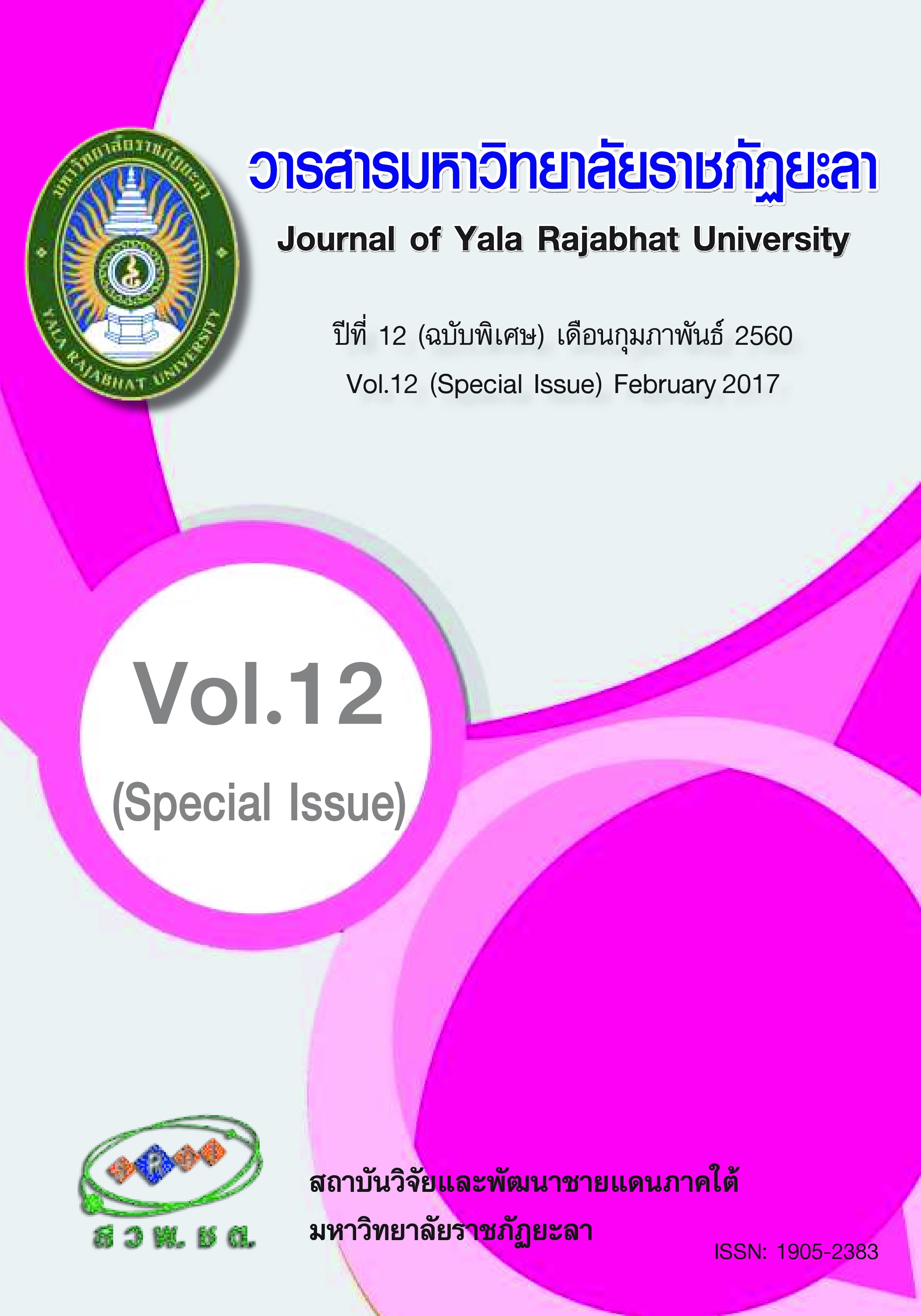ความสัมพันธ์เชิงสาเหตุระหว่างความพยายามสร้างความสัมพันธ์กับทัศนคติและพฤติกรรมของลูกค้า : กรณีศึกษาซูเปอร์เซ็นเตอร์ในจังหวัดมหาสารคาม
Main Article Content
บทคัดย่อ
การวิจัยนี้มีวัตถุประสงค์เพื่อทดสอบความกลมกลืนของโมเดลการวิจัยความพยายามสร้างความสัมพันธ์ที่พัฒนาขึ้นกับข้อมูลเชิงประจักษ์และศึกษาความสัมพันธ์เชิงสาเหตุระหว่างความพยายามสร้างความสัมพันธ์ของซูเปอรเซ็นเตอร์ ซึ่งประกอบด้วย การส่งข่าวสารทางตรงการมอบสิทธิพิเศษ และรางวัลที่จับต้องได้ กับผลลัพธ์เชิงความสัมพันธ์กับลูกค้า ในด้านการไว้วางใจ การผูกพันเชิงความสัมพันธ์ และความจงรักภักดี โดยทำการเก็บข้อมูลด้วยแบบสอบถามจากลูกค้าที่มาใช้บริการซูเปอร์เซ็นเตอร์ ด้วยวิธีการสุ่มแบบอิสระอย่างง่าย (Simple random sampling) จานวน 431 คน และวิเคราะห์ข้อมูลโดยใช้โมเดลสมการโครงสร้าง (Structural Equation Modeling: SEM) ด้วยโปรแกรม LISREL ผลการวิเคราะห์ข้อมูลพบว่า (1) โมเดลการวิจัยมีความกลมกลืนกับข้อมูลเชิงประจักษ์ (X2= 244.65, df=176, P<0.05,X2/df= 1.39, GFI= 0.96 AGFI= 0.99, RMR= 0.030) และ (2) ซูเปอร์เซ็นเตอร์ที่พยายามสร้างความสัมพันธ์กับลูกค้าโดยการมอบสิทธิพิเศษ จะทำให้ลูกค้าเกิดความไว้วางใจ (ขนาดอิทธิพลเท่ากับ 1.26) และยังผลให้ลูกค้าเกิดความผูกพัน (ขนาดอิทธิพลเท่ากับ 1.00) และความจงรักภักดีทั้งในเชิงทัศนคติและพฤติกรรมการบริโภคที่เพิ่มขึ้น (ขนาดอิทธิพลเท่ากับ 1.00) ในทางกลับกัน การส่งข่าวสารทางตรงและรางวัลที่จับต้องได้ ไม่มีความสัมพันธ์อย่างมีนัยสาคัญกับความไว้วางใจของลูกค้า ดังนั้นการกำหนดกลยุทธ์ทางการตลาดที่มุ่งสร้างคุณค่าให้กับลูกค้าตลอดจนการพัฒนาทักษะ ความสามารถในการให้บริการและการสร้างแรงจูงใจให้กับพนักงานทุกระดับเป็นสิ่งจำเป็นเพื่อพัฒนาความตั้งใจและความพยายามในการสร้างความสัมพันธ์และทำให้ลูกค้าเป็นลูกค้าที่มีความจงรักภักดีเพิ่มขึ้น
Article Details
บทความ ข้อมูล เนื้อหา รูปภาพ ฯลฯ ที่ได้รับการเผยแพร่ในวารสารมหาวิทยาลัยราชภัฏยะลานี้ ถือเป็นลิขสิทธิ์ของวารสารมหาวิทยาลัยราชภัฏยะลา หากบุคคลหรือหน่วยงานใดต้องการนำทั้งหมดหรือส่วนหนึ่งส่วนใดไปเผยแพร่ต่อหรือกระทำการใดๆ จะต้องได้รับอนุญาตเป็นลายลักษณ์อักษรจากวารสารมหาวิทยาลัยราชภัฏยะลาก่อนเท่านั้น
เอกสารอ้างอิง
2.Chen, S.C. (2015). Customer Value and Customer Loyalty: Is Competition a Missing Link?. Journal of Retailing and Consumer Services, 22, 107-116.
3.Dzuranin, A. & Stuart, N. (2012). The Effect of Tangible and Intangible Noncash Rewards on Performance and Satisfaction in a Production Setting. Management Accounting Quarterly, 13(4), 1-10.
4.Gázquez-Abad, J. C., Hèléne De Canniére, M. & Martínez-López, F. J. (2011). Dynamic of Customer Response to Promotional and Relational Direct mails from an Apparel Retailer: The Moderating Role of Relationship Strength. Journal of Retailing, 87, 199-181.
5.Hassan, H., Sade, A. B. & Rahman, M. S. (2013). Malaysian Hypermarket Retailing Development and Expansion. International Journal of Retailing & Distribution Management, 41(8), 584-595.
6.Huang, M. H. (2015). The Influence of Relationship Marketing Investment on Customer Gratitude in Retailing. Journal of Business Research, 68, 1318-1323.
7.Institute for Small and Medium Enterprises Development. (2014). The Formulation of Strategy and Operating Plan for Supporting Small and Medium Enterprise [Online]. Retrieved January 20, 2016, from: http://www.sme.go.th/SiteCollectionDocuments/Final.pdf.
8.Lacey, R., Suh, J. & Morgan, R. M. (2007). Differential Effects of Preferential Treatment Level on Relational Outcomes. Journal of Service Research, 9(3), 241-256.
9.Ma, S., Hou, L., Yao, W. & Lee, B. (2016). A Non Homogeneous Hidden Markov Model of Response Dynamics and Mailing Optimization in Direct Marketing. European Journal of Operational Research, 253, 514-523.
10.Morgan, R. M. & Hunt, S. D. (1994). The Commitment-trust Theory of Relationship Marketing. Journal of Marketing, 58(3), 20-38.
11.Nunnally, J. C. & Bernstein, L. H. (1999). Psychometric Theory. Journal of Psychoeducational Assessment, 17, 275-280.
12.Rod, M., Ashill, N. J. & Gibbs, T. (2016). Customer Perceptions of Frontline Employee Service Delivery: A Study of Russian Bank Customer Satisfaction and Behavioral Intentions. Journal of Retailing and Consumer Services, 30, 212-221.
13.Sakhakara, K. (2011). The Influences and Impacts of Hypermarkets of Urban Commercial Land Values and Land-use Succession in their Trading Areas in Thailand’s Cities: The Case Studies of Chiang Rai, Lam Pang, Nakhon Sawan, and Kampheang Petch. ProQuest Dissertations and Theses. The University of Colorado Denver.
14.Saleh, M. A., Ali, M. Y. & Mavondo, F. T. (2014). Drivers of Importer Trust and Commitment: Evidence from a Developing Country. Journal of Business Research, 67, 2523-2530.
15.Salim, L. (2008). Correlation between Demographic, Socio-economics and Store Loyalty in The Indonesian Modern Retailing Market. Journal of Yala Rajabhat University, 3(2), 147-166. (in Thai)
16.SCB Economic Intelligence Center. (2011). Retail Landscape Change [Online]. Retrieved January 15, 2016, from: http://www.scbeic.com/th/detail/product/245. (in Thai)
17.SCB Economic Intelligence Center. (2014). Keep Watching on Competitive Situation of Grocery Store [Online]. Retrieved January 15, 2016, from: http://www.scbeic.com/th/detail/product/289. (in Thai)
18.Schröder, N. & Hruschka, H. (2016). Investigating the Effects of Mailing Variables and Endogeneity on Mailing Decisions. European Journal of Operational Research, 250, 579-589.
19.Shou, Z., Guo, R., Zhang, Q. & Su, C. (2011). The Many Faces of Trust and Guanxi Behavior: Evidence from Marketing Channels in China. Industrial Marketing Management, 40(4), 503-509.
20.Steenkamp, J. B. E. M. & Van Trijp, H. C. M. (1991). The Use of LISREL in Validating Marketing Constructs. International Journal of Research in Marketing,8, 283-299.
21.Vanichbuncha, K. (2014). Structural Equation Modeling Analysis: AMOS. Bangkok: Samlada Printing. (in Thai)
22.Wulf, K. D. & Odekerken-Schroder, G. (2003). Assessing the Impact of a Retailer’s Relationship Efforts on Consumers’ Attitudes and Behavior. Journal of Retailing and Consumer services, 10, 95-108.
23.Zhao, X., Huo, B., Selen, W. & Yeung, J. H. Y. (2010). The Impact of Internal Integration and Relationship Commitment on External Integration. Journal of Operations Management, doi: 10.1016/j.jom.2010.04.004


